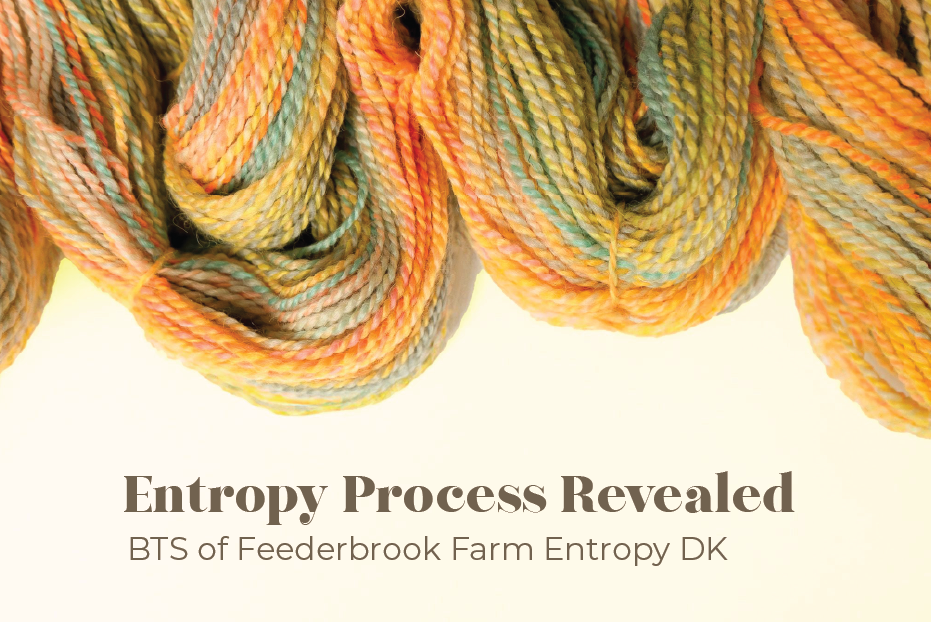If you’ve never heard of the Lleyn (pronounced "clin") sheep, don’t worry—you’re not alone. While not the flashy celeb of the fiber world, this coastal-bred breed from Lleyn Peninsula, North Wales, has quietly earned its place in our yarn lineup. And once you’ve knit with it, you’ll understand why.
Named after the Llŷn Peninsula in Wales where the Lleyn sheep were bred, this wool isn’t just pretty; it’s got some serious pedigree. But what makes it so special? Let’s dive in!

The Bounce Test: What’s in a Fleece?

The legendary wool grader, Mr. I.E. Roberts, recalls his days of grading wool in the 1930s. He says when a good Lleyn fleece was dropped, it would hit the ground quietly and bounce slightly due to the crinkle in the staple. The more crinkle, the more bounce.
Compare that to inferior fleeces, which hit the ground with a dull thud—no bounce, just disappointment. If that doesn’t sound like the world’s most whimsical yarn test, we don’t know what does!

The Comeback Kid
In the mid-1960s, the Lleyn breed was nearly extinct, with only around 500 ewes remaining. But like any great comeback story, it wasn’t over yet. In 1965, a group of breeders crossed Lleyn ewes with Leicester Longwools, saving the breed from genetic issues and disfigured lambs.
Soon after, interest in the Lleyn sheep began to grow again, and by the late 1970s and early 1980s, the breed was gaining international attention in the USA, New Zealand, Australia, and several European countries. By 1970, the Lleyn Sheep Society was formed, boosting the breed’s profile even more.
Today, Lleyn sheep are thriving. Not only are they popular throughout the UK, but even King Charles keeps a flock at his estate. (yes, that King Charles).

The Efficiency and Health Benefits of Lleyn Sheep
One of the standout features of the Lleyn sheep is its ability to efficiently convert grass and forage into both milk and meat, producing high-quality lambs with excellent lambing percentages. The Lleyn ewe is renowned for her maternal ability, milk production, and mothering skills. Ewe lambs grow to a good weight and are long-lived, so ewe depreciation costs are lower.
Another win for the environment: Lleyn sheep are a low environmental impact breed. With fewer methane emissions per kilogram of lamb produced, they help battle climate change. Plus, they thrive on low input conditions, meaning fewer resources are needed to produce the same high-quality products.

Wool Qualities Worth Talking About
Lleyn wool sits comfortably in the medium-soft range. It’s not as fine as Merino, but it’s also not trying to be—it has its own strengths. The fiber has a springy, lofty character that gives excellent stitch definition and just enough tooth to make it a dream for colorwork, cables, and structured garments.
-
Staple length: Around 3.5 to 4.5 inches—plenty to spin or blend beautifully
-
Micron count: Typically in the 30–32 micron range, making it durable without feeling coarse
-
Crimp: Moderate, giving it that lovely bounce without overwhelming elasticity
This is a workhorse wool with personality—sturdy enough for socks and sweaters, but soft enough for hats and mitts. It takes dye beautifully, resulting in rich, earthy hues when hand-dyed, and it blooms nicely after washing without losing structure.

Physical Characteristics and Traits
Lleyn sheep are as elegant as they are efficient. Starting with their distinctive, feminine head, they’re a warm white in color with a wide forehead and good head length—slightly curved and narrowing to a black nose. Their medium-sized ears are thick with charming black spots, and like any good modern wool model, the breed is hornless.
Structurally, they boast a long, low body with a wide breast, a well-sprung rib cage, and plenty of muscle in the haunches and legs. Their average-length legs are clean—there’s no wool below the hock, which keeps things neat and practical. And the tail? It’s docked according to current legal practices.
The Lleyn ewe hits that Goldilocks sweet spot—65 to 70 kg (145 to 155 lbs)—making her the ideal size for producing a 40 kg (88 lb) finished lamb. Too big and she eats too much, too small and her lambs don’t reach market weight. But the Lleyn ewe? She’s just right.
Thanks to this balanced build, Lleyn ewes deliver the highest weight of lamb per hectare. Their ability to thrive on low input while still producing top-quality lambs is not only impressive—it’s essential in today’s farming world. 
How It Feels in Your Hands (and on Your Needles)
Think of Lleyn yarn as that reliable friend who always shows up on time, brings snacks, and can help move furniture. It behaves beautifully on the needles, blocks like a dream, and holds its shape. There’s a rustic charm to it, but without the scratch factor often associated with heritage breeds.
You’ll love it for:
-
Durable sweaters
-
Sturdy yet comfy socks
-
Texture-heavy shawls
-
Outdoor accessories like mittens, hats, and cowls
It’s the kind of yarn that reminds you why we knit with wool in the first place.

Why We Love Lleyn at Bare Naked Wools
We chose Lleyn wool for its balance of structure and softness, and its ability to handle wear while looking refined. Spun to highlight that bounce and natural brightness.
Whether you're knitting a Rhinebeck sweater or a new pair of everyday mitts, Lleyn yarn gives you confidence and charm in every stitch. It's the quiet workhorse your stash has been missing—and now you don’t have to.



